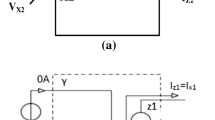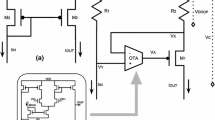Abstract
The proposed architecture features an independent setting of filter poles, while ensuring a constant unity gain. The unity gain simplifies the cascaded connection of filter blocks and avoids the increase of voltage swing for subsequent cascaded blocks observed with other filter architectures. Only the input Operational Amplifier must meet more demanding requirements (in terms of bandwidth and open-loop gain), while the other units are voltage follower units with the possibility of using a video buffer to cope with a demanding load capability. Performances are much better than or comparable to other known filter architectures.
Similar content being viewed by others
References
Analog Devices, AD 810 datasheet, rev. A (2003) (available online www.analog.com)
Analog Devices, ADA 4841-1/-2 datasheet, rev. C (2006) (available online www.analog.com)
A. Budak, D.M. Petrela, Frequency limitations of active filters using operational amplifiers. IEEE Trans. Circuit Theory 19(4), 322–328 (1972)
R.L. Geiger, A. Budak, Active filters with zero amplifier sensitivity. IEEE Trans. Circuits Syst. 26(4), 277–288 (1979)
M.S. Ghausi, Analog active filters. IEEE Trans. Circuits Syst. 31(1), 13–31 (1984)
J.G. Graeme, G.E. Tobey, L.P. Huelsman, Operational Amplifiers—Design and Applications (McGraw Hill, New York, 1971)
L.P. Huelsman, Handbook of Operational Amplifiers RC Active Networks (Burr-Brown Research Corp., Tucson, 1966)
W. Jung (ed.), Op Amp Applications Handbook (Neunes, Burlington, 2005)
K.R. Laker, R. Schaumann, M.S. Ghausi, Multiple-loop feedback topologies for the design of low-sensitivity active filters. IEEE Trans. Circuits Syst. 26(1), 1–21 (1979)
A. Mariscotti, A large bandwidth and dynamic range magnetic field probe, in Proceedings of the IEEE International Measurement Technical Conference IMTC 2007, Warsaw, Poland, 2–4 May 2007, pp. 1–5
S. Natarajan, B.B. Bhattaccharyya, Optimization of RC active filters for extended bandwidth operations. Proc. IEEE 66(2), 260–261 (1978)
National Semiconductors, LMP7717 datasheet, Nov. 2007 (available online www.natsemi.com)
National Semiconductors, LM 6152/4 datasheet, Feb. 2006 (available online www.natsemi.com)
National Semiconductors, LMH6642 datasheet, Oct. 2006 (available online www.natsemi.com)
M.A. Soderstrand, S.K. Mitra, Design of active filters with zero passive Q-sensitivity. IEEE Trans. Circuit Theory 20(3), 289–293 (1973)
Texas Instrument, THS4281 datasheet, Apr. 2004 (available online www.ti.com)
Texas Instrument, TL081/2/4 datasheet, Sep. 2004 (available online www.ti.com)
L. Weyten, Passive element sensitivity of second-order RC active filter sections. IEEE Trans. Circuits Syst. 27(10), 855–862 (1980)
Author information
Authors and Affiliations
Corresponding author
Rights and permissions
About this article
Cite this article
Mariscotti, A. An Active Analog Filter Architecture Ensuring Unity-Gain and Low Sensitivity. Circuits Syst Signal Process 29, 745–756 (2010). https://doi.org/10.1007/s00034-010-9168-6
Received:
Revised:
Published:
Issue Date:
DOI: https://doi.org/10.1007/s00034-010-9168-6




